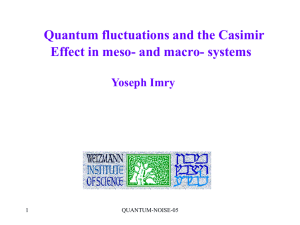C. Casimir effect of Proca fields
advertisement
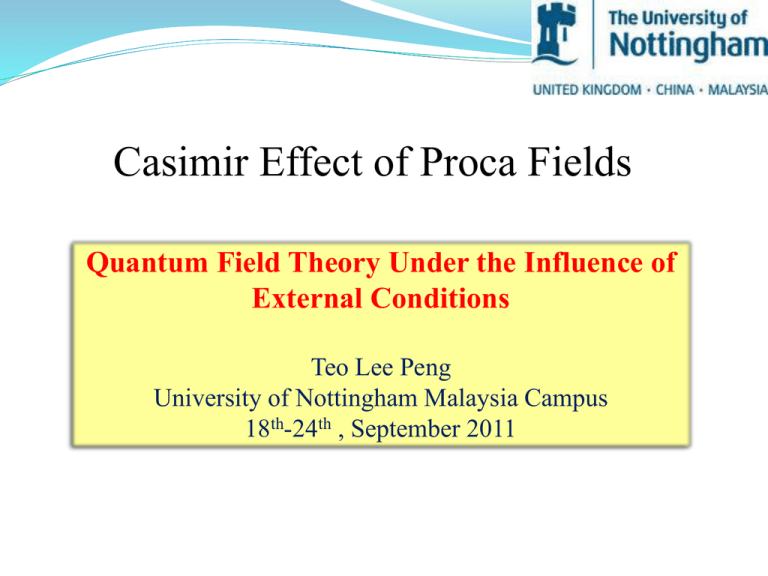
Casimir Effect of Proca Fields Quantum Field Theory Under the Influence of External Conditions Teo Lee Peng University of Nottingham Malaysia Campus 18th-24th , September 2011 Casimir effect has been extensively studied for various quantum fields especially scalar fields (massless or massive) and electromagnetic fields (massless vector fields). One of the motivations to study Casimir effect of massive quantum fields comes from extra-dimensional physics. Using dimensional reduction, a quantum field in a higher dimensional spacetime can be decomposed into a tower of quantum fields in 4D spacetime, all except possibly one are massive quantum fields. In [1], Barton and Dombey have studied the Casimir effect between two parallel perfectly conducting plates due to a massive vector field (Proca field). The results have been used in [2, 3] to study the Casimir effect between two parallel perfectly conducting plates in Kaluza-Klein spacetime and Randall-Sundrum model. In the following, we consider Casimir effect of massive vector fields between parallel plates made of real materials in a magnetodielectric background. This is a report of our work [4]. [1] G. Barton and N. Dombey, Ann. Phys. 162 (1985), 231. [2] A. Edery and V. N. Marachevsky, JHEP 0812 (2008), 035. [3] L.P. Teo, JHEP 1010 (2010), 019. [4] L.P. Teo, Phys. Rev. D 82 (2010), 105002. From electromagnetic field to Proca field Maxwell’s equations Proca’s equations Continuity Equation: (Lorentz condition) Equations of motion for and A: For Proca field, the gauge freedom is lost. Therefore, there are three polarizations. transversal waves Plane waves longitudinal waves For transverse waves, Lorentz condition Equations of motion for A: These have direct correspondences with Maxwell field. Transverse waves Type I (TE) Dispersion relation: Type II (TM) Longitudinal waves Dispersion relation: Note: The dispersion relation for the transverse waves and the longitudinal waves are different unless Longitudinal waves x Boundary conditions: and and must be continuous must be continuous [5] [5] N. Kroll, Phys. Rev. Lett. 26 (1971), 1396. must be continuous must be continuous continuous continuous continuous continuous Lorentz condition continuous continuous continuous continuous Independent Set of boundary conditions: are continuous or are continuous l, l b, b r, r A five-layer model tl a tr Two parallel magnetodielectric plates inside a magnetodielectric medium 2 2 1 1 a1 a2 5 5 4 4 3 3 a3 a4 For type I transverse modes, assume that and are automatically continuous. Contribution to the Casimir energy from type I transverse modes (TE) There are no type II transverse modes or longitudinal modes that satisfy all the boundary conditions. Therefore, we have to consider their superposition. For superposition of type II transverse modes and longitudinal modes (TM), assume that Contribution to the Casimir energy from combination of type II transverse modes and longitudinal modes (TM): Q, Q∞ are 4×4 matrices In the massless limit, one recovers the Lifshitz formula! Special case I: A pair of perfectly conducting plates When It can be identified as the TE contribution to the Casimir energy of a pair of dielectric plates due to a massless electromagnetic field, where the permittivity of the dielectric plates is [2]: 4 0 x 10 Casimir force (N) -2 -4 FTE ,n =1 Cas b -6 FTM ,n =1 Cas b FCas, nb = 1 -8 FTE ,n =2 Cas b -10 FTM ,n =2 Cas b -12 FCas, nb = 2 -14 0 20 40 60 80 100 mass (eV) The dependence of the Casimir forces on the mass m when the background medium has refractive index 1 and 2. Here a = tl = tr = 10nm. Special case II: A pair of infinitely permeable plates It can be identified as the TE contribution to the Casimir energy of a pair of dielectric plates due to a massless electromagnetic field, where the permittivity of the dielectric plates is: 4 0 x 10 Casimir force (N) -2 -4 FTE ,n =1 Cas b -6 FTM ,n =1 Cas b -8 FCas, nb = 1 FTE ,n =2 Cas b -10 FTM ,n =2 Cas b -12 -14 0 FCas, nb = 2 20 40 60 mass (eV) 80 100 The dependence of the Casimir forces on the mass m when the background medium has refractive index 1 and 2. Here a = tl = tr = 10nm. Special case III: One plate is perfectly conducting and one plate is infinitely permeable. 4 Casimir force (N) 12 x 10 10 FTE ,n =1 Cas b 8 FTM ,n =1 Cas b FCas, nb = 1 6 FTE ,n =2 Cas b 4 FTM ,n =2 Cas b 2 FCas, nb = 2 0 -2 0 20 40 60 mass (eV) 80 100 The dependence of the Casimir forces on the mass m when the background medium has refractive index 1 and 2. Here a = tl = tr = 10nm. Perfectly conducting concentric spherical bodies a3 a2 a1 Contribution to the Casimir energy from TE modes Contribution to the Casimir energy from TM modes The continuity of implies that in the perfectly conducting bodies, the type II transverse modes have to vanish. In the perfectly conducting bodies, In the vacuum separating the spherical bodies, 100 0 -100 Cas ETM /E 0 -200 -300 m = 0 eV m = 10-5 eV -400 -4 m = 10 eV -500 -600 -700 -800 1 1.2 1.4 1.6 a2/a1 1.8 2 0 -200 -400 ECas/E0 m = 0 eV -600 m = 10 -5 eV -800 m = 10 -4 eV -1000 -1200 -1400 -1600 1 1.2 1.4 1.6 a2/a1 1.8 2 -1200 0 a2/a1 = 1.1 -1300 ECas/E0 ECas/E0 -5 -1400 a2/a1 = 1.5 -10 -1500 -1600 2 4 6 m (eV) 8 10 x 10 -5 -15 2 4 6 m (eV) 8 10 x 10 -5 THANK YOU
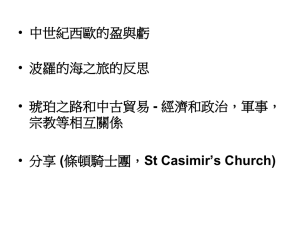
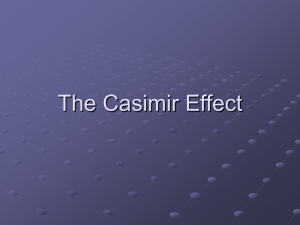
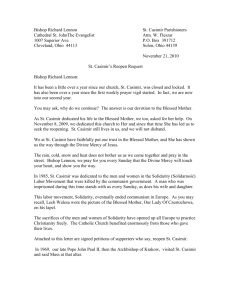
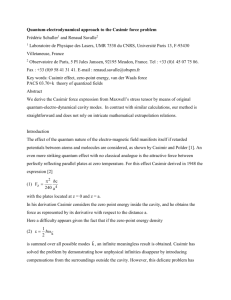
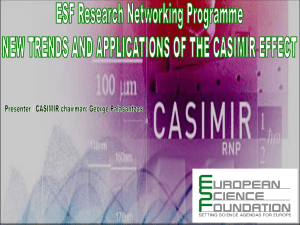


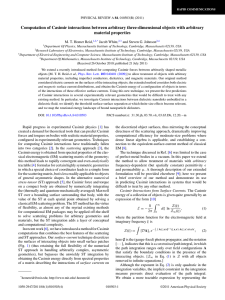
![*in memory of Larry Spruch (1923-2006) A73 [hep-th/0604119];[quant-ph/0705.3435].](http://s2.studylib.net/store/data/010565858_1-2fae8126b606a24fa53150d768730c35-300x300.png)

